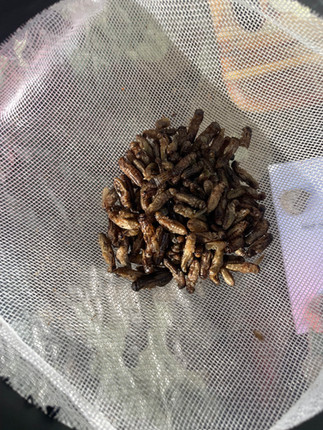Future food? Eating insects at the Powderham Food Festival
- Veronica

- Oct 10, 2023
- 4 min read
Over the weekend, Brett and I cycled along the River Exe to Powderham Castle for their annual Food Festival. The weather was remarkable (although slightly climate-anxiety-inducing for October) and we had a delightful time relaxing in the sun, eating bao buns, and drinking Pimms. I always love seeing how food brings people together!

As someone interested in "future food," one particular highlight of the afternoon was the opportunity to taste insects! While I have eaten bugs at previous events, Brett had never "willingly" eaten insects before (he admitted he'd probably eaten spiders in his sleep, but while writing this blog post we learnt that this widely known "fact" is just a popular myth).
The men running the insect-tasting stall were from Under the Canopy Cornwall – a group that runs outdoor bushcraft and survival adventures. Spread across three tables were multiple insect-based tasters. As one of the demonstrators explained, the bugs had been purchased from Crunchy Critters, a UK-based company that commercially farms insects specifically for human consumption. A recent review of research on the human consumption of insects found that Western consumers are hesitant to eat insects for a number of reasons, including disgust and a lack of experience. Stalls like the one at the Powderham Food Festival can help overcome some of these barriers, by providing us an opportunity to taste insects and overcome the initial disgust we may feel.
To ease us into it, the first taster was a biscuit made of cricket flour. Brett looked sceptical, but reluctantly tried some. As he explained to me later: "It's the mental block of eating something you think of as a pest or animal food, so eating it as a flour made it a lot easier." We couldn't even tell we were eating insects!
Next up were honey roasted locusts, dipped in warm chocolate fondue. While we both enjoyed the flavour, the crunchy texture was a little less appetising. As Brett commented, "I didn't like the crunch as much because it drew attention to the fact I was eating a bug."
At the last table, the demonstrator was preparing grasshopper fajitas, explaining each step of the process as he went. He sautéed the vegetables before adding a homemade spice mix and a handful of rehydrated grasshoppers. We both enjoyed the fajitas – the spices were delicious and, like the cricket flour, eating the grasshoppers as part of a fajita "masked the fact that you're eating a bug."
There was one taster we both declined – live mealworms. I couldn't bring myself to try one of the still-wriggling insects, so I was mightily impressed at the people who were willing to pop them into their mouths.
Reflecting on his first experience eating insects, Brett said, "I would eat bugs again, but probably in the form of flour or fajita-like meals, where it's less obvious you're eating insects." While this bug-tasting may have helped Brett overcome some of the initial barriers of disgust and lack of experience, the cost of buying insects is definitely still a barrier. In the UK, a 100g bag of cricket flour is £7.99, while half a pint (57g) of crickets will set you back £8.99 – significantly more expensive than traditional alternatives (for example, 1.5kg of organic plain flour is £1.55, 250g of vegan protein powder costs £9.00, and 300g of chicken is £2.60). Until these prices come down, I can't see many of us incorporating insects into our diet.
With my (super-scientific) sample size of one, we can see that the visual aspect of eating insects is important. As Brett admitted, "when you eat meat, it doesn't look like the animal it comes from, whereas a bug does," adding that, "insect flour would be super easy to incorporate, because you don't know it's a bug at all." This reflects findings in the review paper that "the visibility of insects in a food product was identified as a barrier" to consumption. Ground insects can, perhaps, offer an alternative to whole insects, and may be able to improve consumer acceptance.

Recognising the visual element of insect consumption, I was curious how insects are visualised in online articles about "future food." After a very quick (and non-systematic) Google search, here are some examples of what I found in the media...

Looks delicious...right?
Not exactly.
In her book chapter, Heidi Kosonen argues that the media can perpetuate the "yuck-factor" of eating insects by using images of "a mass of cooked or raw insects that could be either dead or alive" or photographs that imply "eating the insect whole and/or unprepared." These visual tropes are clear even within the limited sample of media imagery I collected.
I'm glad Brett and I got the opportunity to taste some insects at the Powderham Food Festival – experiences like this seem ideal for getting consumers to engage with different visions of future food systems. And whether or not insects are indeed the "future of food," the visual aspect of insect consumption is something that could be interesting to explore further as part of my PhD.












Comentarios